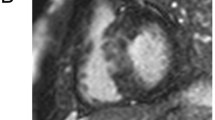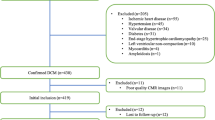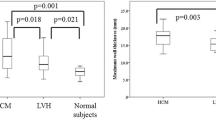Abstract
An ECG risk-score has been described that predicts high risk of subsequent cardiac arrest in young patients with hypertrophic cardiomyopathy (HCM). Myocardial fibrosis measured by cardiac magnetic resonance (CMR) late gadolinium enhancement (LGE) also affects prognosis. We assessed whether an ECG risk-score could be used as an indicator of myocardial fibrosis or perfusion deficit on CMR in HCM. In total 42 individuals (7–31 years); 26 HCM patients, seven genotype-positive, phenotype-negative individuals at risk of HCM (first-degree relatives) and nine healthy volunteers, underwent CMR to identify, and grade extent of, myocardial fibrosis and perfusion defect. 12-lead ECG was used for calculating the ECG risk-score (grading 0–14p). High-risk ECG (risk-score > 5p) occurred only in the HCM group (9/26), and the proportion was significantly higher vs mutation carriers combined with healthy volunteers (0/16, p = 0.008). Extent of LGE correlated to the ECG-score (R2 = 0.47, p = 0.001) in sarcomeric mutations. In low-risk ECG-score patients (0–2p), median percent of myocardium showing LGE (LGE%LVM) were: 0% [interquartile range, IQR, 0–0%], in intermediate-risk (3–5p): 5.4% [IQR 0–13.5%] and in high-risk (6–14p): 10.9% [IQR 4.2–12.3%]. ECG-score > 2p had a sensitivity and specificity of 79% and 84% to detect positive LGE on CMR and 77% vs. 75% to detect perfusion defects in sarcomeric mutations carriers. In patients with myocardial fibrosis as identified by LGE, median ECG risk-score was 8p [range 3–10p]. In conclusions, ECG risk-score > 2 p could be used as a cut-off for screening of myocardial fibrosis. Thus ECG risk-score is an inexpensive complementary tool in risk stratification of HCM in the young.

Similar content being viewed by others
Data Availability
Data and material are available after contacting the corresponding author.
Code Availability
Microsoft Office, SPSS and MedCalc (https://www.medcalc.org/calc/diagnostic_test.php).
References
Maron BJ, Maron MS (2013) Hypertrophic cardiomyopathy. Lancet 381(9862):242–255. https://doi.org/10.1016/S0140-6736(12)60397-3
Moak JP, Kaski JP (2012) Hypertrophic cardiomyopathy in children. Heart 98(14):1044–1054. https://doi.org/10.1136/heartjnl-2011-300531
Basso C, Thiene G, Corrado D, Buja G, Melacini P, Nava A (2000) Hypertrophic cardiomyopathy and sudden death in the young: pathologic evidence of myocardial ischemia. Hum Pathol 31(8):988–998. https://doi.org/10.1053/hupa.2000.16659
Gyllenhammar T, Fernlund E, Jablonowski R, Jogi J, Engblom H, Liuba P, Arheden H, Carlsson M (2014) Young patients with hypertrophic cardiomyopathy, but not subjects at risk, show decreased myocardial perfusion reserve quantified with CMR. Eur Heart J Cardiovasc Imaging 15(12):1350–1357. https://doi.org/10.1093/ehjci/jeu137
Camaioni C, Knott KD, Augusto JB, Seraphim A, Rosmini S, Ricci F, Boubertakh R, Xue H, Hughes R, Captur G, Lopes LR, Brown LAE, Manisty C, Petersen SE, Plein S, Kellman P, Mohiddin SA, Moon JC (2019) Inline perfusion mapping provides insights into the disease mechanism in hypertrophic cardiomyopathy. Heart. https://doi.org/10.1136/heartjnl-2019-315848
Jablonowski R, Fernlund E, Aletras AH, Engblom H, Heiberg E, Liuba P, Arheden H, Carlsson M (2015) Regional stress-induced ischemia in non-fibrotic hypertrophied myocardium in young HCM patients. PediatrCardiol 36(8):1662–1669. https://doi.org/10.1007/s00246-015-1214-5
Bravo PE, Zimmerman SL, Luo HC, Pozios I, Rajaram M, Pinheiro A, Steenbergen C, Kamel IR, Wahl RL, Bluemke DA, Bengel FM, Abraham MR, Abraham TP (2013) Relationship of delayed enhancement by magnetic resonance to myocardial perfusion by positron emission tomography in hypertrophic cardiomyopathy. CircCardiovasc Imaging 6(2):210–217. https://doi.org/10.1161/CIRCIMAGING.112.000110
Varnava AM, Elliott PM, Sharma S, McKenna WJ, Davies MJ (2000) Hypertrophic cardiomyopathy: the interrelation of disarray, fibrosis, and small vessel disease. Heart 84(5):476–482. https://doi.org/10.1136/heart.84.5.476
Moon JC, McKenna WJ, McCrohon JA, Elliott PM, Smith GC, Pennell DJ (2003) Toward clinical risk assessment in hypertrophic cardiomyopathy with gadolinium cardiovascular magnetic resonance. J Am CollCardiol 41(9):1561–1567. https://doi.org/10.1016/s0735-1097(03)00189-x
O’Hanlon R, Grasso A, Roughton M, Moon JC, Clark S, Wage R, Webb J, Kulkarni M, Dawson D, Sulaibeekh L, Chandrasekaran B, Bucciarelli-Ducci C, Pasquale F, Cowie MR, McKenna WJ, Sheppard MN, Elliott PM, Pennell DJ, Prasad SK (2010) Prognostic significance of myocardial fibrosis in hypertrophic cardiomyopathy. J Am CollCardiol 56(11):867–874. https://doi.org/10.1016/j.jacc.2010.05.010
Adabag AS, Maron BJ, Appelbaum E, Harrigan CJ, Buros JL, Gibson CM, Lesser JR, Hanna CA, Udelson JE, Manning WJ, Maron MS (2008) Occurrence and frequency of arrhythmias in hypertrophic cardiomyopathy in relation to delayed enhancement on cardiovascular magnetic resonance. J Am CollCardiol 51(14):1369–1374. https://doi.org/10.1016/j.jacc.2007.11.071
Neubauer S, Kolm P, Ho CY, Kwong RY, Desai MY, Dolman SF, Appelbaum E, Desvigne-Nickens P, DiMarco JP, Friedrich MG, Geller N, Harper AR, Jarolim P, Jerosch-Herold M, Kim DY, Maron MS, Schulz-Menger J, Piechnik SK, Thomson K, Zhang C, Watkins H, Weintraub WS, Kramer CM, Investigators H (2019) Distinct subgroups in hypertrophic cardiomyopathy in the NHLBI HCM registry. J Am CollCardiol 74(19):2333–2345. https://doi.org/10.1016/j.jacc.2019.08.1057
Gersh BJ, Maron BJ, Bonow RO, Dearani JA, Fifer MA, Link MS, Naidu SS, Nishimura RA, Ommen SR, Rakowski H, Seidman CE, Towbin JA, Udelson JE, Yancy CW, American College of Cardiology Foundation/American Heart Association Task Force on Practice G (2011) 2011 ACCF/AHA Guideline for the Diagnosis and Treatment of Hypertrophic Cardiomyopathy: a report of the American College of Cardiology Foundation/American Heart Association Task Force on Practice Guidelines. Developed in collaboration with the American Association for Thoracic Surgery, American Society of Echocardiography, American Society of Nuclear Cardiology, Heart Failure Society of America, Heart Rhythm Society, Society for Cardiovascular Angiography and Interventions, and Society of Thoracic Surgeons. J Am CollCardiol 58(25):e212-260. https://doi.org/10.1016/j.jacc.2011.06.011
Authors/Task Force m, Elliott PM, Anastasakis A, Borger MA, Borggrefe M, Cecchi F, Charron P, Hagege AA, Lafont A, Limongelli G, Mahrholdt H, McKenna WJ, Mogensen J, Nihoyannopoulos P, Nistri S, Pieper PG, Pieske B, Rapezzi C, Rutten FH, Tillmanns C, Watkins H (2014) 2014 ESC Guidelines on diagnosis and management of hypertrophic cardiomyopathy: the Task Force for the Diagnosis and Management of Hypertrophic Cardiomyopathy of the European Society of Cardiology (ESC). Eur Heart J 35(39):2733–2779. https://doi.org/10.1093/eurheartj/ehu284
Ostman-Smith I, Wisten A, Nylander E, Bratt EL, Granelli A, Oulhaj A, Ljungstrom E (2010) Electrocardiographic amplitudes: a new risk factor for sudden death in hypertrophic cardiomyopathy. Eur Heart J 31(4):439–449. https://doi.org/10.1093/eurheartj/ehp443
Ostman-Smith I, Sjoberg G, Rydberg A, Larsson P, Fernlund E (2017) Predictors of risk for sudden death in childhood hypertrophic cardiomyopathy: the importance of the ECG risk score. Open Heart 4(2):e000658. https://doi.org/10.1136/openhrt-2017-000658
McLeod CJ, Ackerman MJ, Nishimura RA, Tajik AJ, Gersh BJ, Ommen SR (2009) Outcome of patients with hypertrophic cardiomyopathy and a normal electrocardiogram. J Am CollCardiol 54(3):229–233. https://doi.org/10.1016/j.jacc.2009.02.071
O’Mahony C, Jichi F, Pavlou M, Monserrat L, Anastasakis A, Rapezzi C, Biagini E, Gimeno JR, Limongelli G, McKenna WJ, Omar RZ, Elliott PM, Hypertrophic Cardiomyopathy Outcomes I (2014) A novel clinical risk prediction model for sudden cardiac death in hypertrophic cardiomyopathy (HCM risk-SCD). Eur Heart J 35(30):2010–2020. https://doi.org/10.1093/eurheartj/eht439
Norrish G, Ding T, Field E, Ziolkowska L, Olivotto I, Limongelli G, Anastasakis A, Weintraub R, Biagini E, Ragni L, Prendiville T, Duignan S, McLeod K, Ilina M, Fernandez A, Bokenkamp R, Baban A, Kubus P, Daubeney PEF, Sarquella-Brugada G, Cesar S, Marrone C, Bhole V, Medrano C, Uzun O, Brown E, Gran F, Castro FJ, Stuart G, Vignati G, Barriales-Villa R, Guereta LG, Adwani S, Linter K, Bharucha T, Garcia-Pavia P, Rasmussen TB, Calcagnino MM, Jones CB, De Wilde H, Toru-Kubo J, Felice T, Mogensen J, Mathur S, Reinhardt Z, O’Mahony C, Elliott PM, Omar RZ, Kaski JP (2019) Development of a novel risk prediction model for sudden cardiac death in childhood hypertrophic cardiomyopathy (HCM risk-kids). JAMA Cardiol. https://doi.org/10.1001/jamacardio.2019.2861
Miron A, Lafreniere-Roula M, Steve Fan CP, Armstrong KR, Dragulescu A, Papaz T, Manlhiot C, Kaufman B, Butts RJ, Gardin L, Stephenson EA, Howard TS, Aziz PF, Balaji S, Ladouceur VB, Benson LN, Colan SD, Godown J, Henderson HT, Ingles J, Jeewa A, Jefferies JL, Lal AK, Mathew J, Jean-St-Michel E, Michels M, Nakano SJ, Olivotto I, Parent JJ, Pereira AC, Semsarian C, Whitehill RD, Wittekind SG, Russell MW, Conway J, Richmond ME, Villa C, Weintraub RG, Rossano JW, Kantor PF, Ho CY, Mital S (2020) A validated model for sudden cardiac death risk prediction in pediatric hypertrophic cardiomyopathy. Circulation 142(3):217–229. https://doi.org/10.1161/CIRCULATIONAHA.120.047235
Pettersen MD, Du W, Skeens ME, Humes RA (2008) Regression equations for calculation of z scores of cardiac structures in a large cohort of healthy infants, children, and adolescents: an echocardiographic study. J Am SocEchocardiogr 21(8):922–934. https://doi.org/10.1016/j.echo.2008.02.006
Ostman-Smith I (2010) Hypertrophic cardiomyopathy in childhood and adolescence—strategies to prevent sudden death. FundamClinPharmacol 24(5):637–652. https://doi.org/10.1111/j.1472-8206.2010.00869.x
Heiberg E, Sjogren J, Ugander M, Carlsson M, Engblom H, Arheden H (2010) Design and validation of Segment–freely available software for cardiovascular image analysis. BMC Med Imaging 10:1. https://doi.org/10.1186/1471-2342-10-1
Engblom H, Tufvesson J, Jablonowski R, Carlsson M, Aletras AH, Hoffmann P, Jacquier A, Kober F, Metzler B, Erlinge D, Atar D, Arheden H, Heiberg E (2016) A new automatic algorithm for quantification of myocardial infarction imaged by late gadolinium enhancement cardiovascular magnetic resonance: experimental validation and comparison to expert delineations in multi-center, multi-vendor patient data. J CardiovascMagnReson 18(1):27. https://doi.org/10.1186/s12968-016-0242-5
Crilley JG, Boehm EA, Blair E, Rajagopalan B, Blamire AM, Styles P, McKenna WJ, Ostman-Smith I, Clarke K, Watkins H (2003) Hypertrophic cardiomyopathy due to sarcomeric gene mutations is characterized by impaired energy metabolism irrespective of the degree of hypertrophy. J Am CollCardiol 41(10):1776–1782. https://doi.org/10.1016/s0735-1097(02)03009-7
Arad M, Benson DW, Perez-Atayde AR, McKenna WJ, Sparks EA, Kanter RJ, McGarry K, Seidman JG, Seidman CE (2002) Constitutively active AMP kinase mutations cause glycogen storage disease mimicking hypertrophic cardiomyopathy. J Clin Invest 109(3):357–362. https://doi.org/10.1172/JCI14571
Banankhah P, Fishbein GA, Dota A, Ardehali R (2018) Cardiac manifestations of PRKAG2 mutation. BMC Med Genet 19(1):1. https://doi.org/10.1186/s12881-017-0512-6
Park CH, Chung H, Kim Y, Kim JY, Min PK, Lee KA, Yoon YW, Kim TH, Lee BK, Hong BK, Rim SJ, Kwon HM, Choi EY (2018) Electrocardiography based prediction of hypertrophy pattern and fibrosis amount in hypertrophic cardiomyopathy: comparative study with cardiac magnetic resonance imaging. Int J Cardiovasc Imaging 34(10):1619–1628. https://doi.org/10.1007/s10554-018-1365-6
Delcre SD, Di Donna P, Leuzzi S, Miceli S, Bisi M, Scaglione M, Caponi D, Conte MR, Cecchi F, Olivotto I, Gaita F (2013) Relationship of ECG findings to phenotypic expression in patients with hypertrophic cardiomyopathy: a cardiac magnetic resonance study. Int J Cardiol 167(3):1038–1045. https://doi.org/10.1016/j.ijcard.2012.03.074
Chen X, Zhao T, Lu M, Yin G, Xiangli W, Jiang S, Prasad S, Zhao S (2014) The relationship between electrocardiographic changes and CMR features in asymptomatic or mildly symptomatic patients with hypertrophic cardiomyopathy. Int J Cardiovasc Imaging 30(Suppl 1):55–63. https://doi.org/10.1007/s10554-014-0416-x
Morimoto Y, Miyazaki A, Tsuda E, Hayama Y, Negishi J, Ohuchi H (2020) Electrocardiographic changes and long-term prognosis of children diagnosed with hypertrophic cardiomyopathy by the school screening program for heart disease in Japan. J Cardiol 75(5):571–577. https://doi.org/10.1016/j.jjcc.2019.10.008
Grall S, Biere L, Clerfond G, Mateus V, Prunier F, Furber A (2014) ECG characteristics according to the presence of late gadolinium enhancement on cardiac MRI in hypertrophic cardiomyopathy. Open Heart 1(1):e000101. https://doi.org/10.1136/openhrt-2014-000101
Axelsson Raja A, Farhad H, Valente AM, Couce JP, Jefferies JL, Bundgaard H, Zahka K, Lever H, Murphy AM, Ashley E, Day SM, Sherrid MV, Shi L, Bluemke DA, Canter CE, Colan SD, Ho CY (2018) Prevalence and progression of late gadolinium enhancement in children and adolescents with hypertrophic cardiomyopathy. Circulation 138(8):782–792. https://doi.org/10.1161/CIRCULATIONAHA.117.032966
Rubinshtein R, Glockner JF, Ommen SR, Araoz PA, Ackerman MJ, Sorajja P, Bos JM, Tajik AJ, Valeti US, Nishimura RA, Gersh BJ (2010) Characteristics and clinical significance of late gadolinium enhancement by contrast-enhanced magnetic resonance imaging in patients with hypertrophic cardiomyopathy. Circ Heart Fail 3(1):51–58. https://doi.org/10.1161/CIRCHEARTFAILURE.109.854026
Acknowledgements
We are deeply grateful to the support from the study participants during the study. The authors would like to thank the technicians Ann-Helen Arvidsson and Christel Carlander for their help with CMR data acquisition. Special thanks to research nurse Annika Maxedius for excellent support in the study.
Funding
This study has been possible by support and grants from Region Ostergotland (ALF and the Office for Trainee and Fellowship programs), the Strategic Research Area in Forensic Science, Schelins Foundation and FORSS (Medical Research Council of Southeast Sweden).
Author information
Authors and Affiliations
Contributions
All authors contributed to the study conception and design. Material preparation and data collection were performed by AWÖ, RJ, MC, and EF. Analysis was performed by AWÖ with support from all other authors. The first draft of the manuscript was written by AWÖ and all authors commented on previous versions of the manuscript. All authors have read and approved the final manuscript. All the above authors take responsibility for all aspects of the reliability and freedom from bias of the data presented and their discussed interpretation.
Corresponding author
Ethics declarations
Conflicts of interest
The authors declare that they have no conflicts of interest.
Ethical Approval
The study was approved by the Regional Ethical Review Board in Lund, Sweden, H15 2009/616 and 2011/668. The study conforms to the ethical guidelines of the 1975 Declaration of Helsinki.
Informed Consent
An informed consent was obtained from all participants or their legal guardians (for participants < 18 years of age).
Additional information
Publisher's Note
Springer Nature remains neutral with regard to jurisdictional claims in published maps and institutional affiliations.
Electronic supplementary material
Below is the link to the electronic supplementary material.
Rights and permissions
About this article
Cite this article
Österberg, A.W., Östman-Smith, I., Jablonowski, R. et al. High ECG Risk-Scores Predict Late Gadolinium Enhancement on Magnetic Resonance Imaging in HCM in the Young. Pediatr Cardiol 42, 492–500 (2021). https://doi.org/10.1007/s00246-020-02506-9
Received:
Accepted:
Published:
Issue Date:
DOI: https://doi.org/10.1007/s00246-020-02506-9




